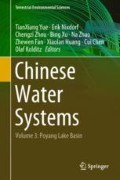Abstract
Macrophyte is an ecologically-diverse taxon that consists of a type of different groups of plants that adapt to the aquatic environment over a long period of time, such as aquatic vascular plants and higher algae (Chara, etc.). Macrophytes can be classified into four different types based on growth form: Emergent macrophytes, floating macrophytes, floating-leaved macrophytes and submergent macrophytes. Aquatic macrophytes exist between water-sediment, water-air and water-land interface. They are important components of the lake ecosystem and are important regulators of lake evolution and lake ecological balance. Besides, they improve water quality and increase the stability of water environment by inhibiting the growth of phytoplankton and thus reduce the stock of algae. So they are often used as indicators of changes in the lake environment and as a basis for establishing good lake ecology.
Access this chapter
Tax calculation will be finalised at checkout
Purchases are for personal use only
References
State Environmental Protection Administration of China. 2002. In Water and wastewater monitoring and analysis method. China Environmental Science Press.
Liu, L., et al. 2008. Determination of heavy metals in soils and plants with microwavedigestion and ICP-AES (in Chinese). Environmental Chemistry 27 (4): 511–514.
Poyang Lake research Editorial board. 1988. In Research on Poyang Lake (in Chinese).
Xia, J. 1996. In Detailed explanation of soil environmental quality standard (in Chinese), 84–86.
Ma, T., et al. 2011. Potential ecological risk assessment of heavy metal pollutants in surface sediments of the lakes in Nanjing (in Chinese). Journal of Ecology and Rural Environment 6: 37–42.
Li, Z. J. Ding, and L. Peng. 2004. The principle and method of environmental quality evaluation, Chemistry IndustryPublishing House, Beijing.
Jian, M., L. Li, H. Yu, J. Xiong, and G. Yu. 2015. Heavy metals pollution on the water and sediments and its influence on the submerged macrophyte community in the wetland of Poyang lake (in Chinese). Ecology and Environmental Sciences 24: 96–105.
Xu, Z., S. Ni, X. Tuo, and C. Zhang. 2008. Calculation of heavy metals’ toxicity coefficient in the evaluation of potential ecological risk index (in Chinese). Environmental Science & Technology 2 (8): 112–115.
Jian, M., M. Jian, L. Li, and Other. 2015. Distribution pattern of submerged plants in typical wetlands of Poyang Lake and its influence factors of water environment (in Chinese). In Resources & environment in the Yangtze Basin 24.5, 765–772.
Li, K., Y. Hu, Y. Fan, and Other. 2007. Influence of environmental factors on distribution of plant communities and composition of species in alpine grassland (in Chinese). Chinese Journal of Agrometeorology 28.4: 378–382.
Yang, Q., and J. Zhang. 2000. The ordination axes clustering based on detrended canonical correspondence analysis ordination and its application to theanalysis of the ecological gradients of plant communities (in Chinese). Acta Ecologica Sinica 20 (2): 199–206.
Feng, Y., K. Ma, Y. Zhang, and J. Qi. 2008. DCCA analysis of plant species distributions in different strata of oak (quercus liaotungensis) forest along an altitudinal gradient in Dongling mounta in china (in Chinese). Journal of Plant Ecology 3: 568–573.
Zeng, F., H. Xiao, and W. Zhou. 2009. Distribution and retention of heavy metals in floodplain topsoils of Le’an River. Environmental Science & Technology 2: 96–101.
Author information
Authors and Affiliations
Corresponding author
Editor information
Editors and Affiliations
Rights and permissions
Copyright information
© 2019 Springer Nature Switzerland AG
About this chapter
Cite this chapter
Jian, M. (2019). Distribution of Aquatic Macrophytes in the Le’an River and Its Indicative Evaluation on Heavy Metal Pollution. In: Yue, T., et al. Chinese Water Systems. Terrestrial Environmental Sciences. Springer, Cham. https://doi.org/10.1007/978-3-319-97725-6_10
Download citation
DOI: https://doi.org/10.1007/978-3-319-97725-6_10
Published:
Publisher Name: Springer, Cham
Print ISBN: 978-3-319-97724-9
Online ISBN: 978-3-319-97725-6
eBook Packages: Earth and Environmental ScienceEarth and Environmental Science (R0)

